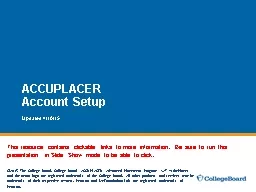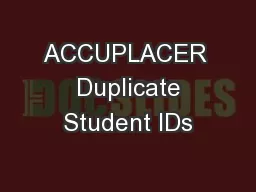PPT-ACCUPLACER
Author : debby-jeon | Published Date : 2017-06-14
Account Setup Updated 41015 2015 The College Board College Board ACCUPLACER Advanced Placement Program SAT WritePlacer and the acorn logo are registered trademarks
Presentation Embed Code
Download Presentation
Download Presentation The PPT/PDF document "ACCUPLACER" is the property of its rightful owner. Permission is granted to download and print the materials on this website for personal, non-commercial use only, and to display it on your personal computer provided you do not modify the materials and that you retain all copyright notices contained in the materials. By downloading content from our website, you accept the terms of this agreement.
ACCUPLACER: Transcript
Download Rules Of Document
"ACCUPLACER"The content belongs to its owner. You may download and print it for personal use, without modification, and keep all copyright notices. By downloading, you agree to these terms.
Related Documents









![[READ] - ACCUPLACER Secrets Study Guide: Practice Questions and Test Review for the ACCUPLACER](https://thumbs.docslides.com/902288/read-accuplacer-secrets-study-guide-practice-questions-and-test-review-for-the-accuplacer-exam.jpg)
![[DOWNLOAD] - ACCUPLACER Secrets Study Guide: Practice Questions and Test Review for the](https://thumbs.docslides.com/906814/download-accuplacer-secrets-study-guide-practice-questions-and-test-review-for-the-accuplacer-exam.jpg)

![[EBOOK] College Math Placement Test Prep Secrets: College Math Placement Test Study Guide,](https://thumbs.docslides.com/1006197/ebook-college-math-placement-test-prep-secrets-college-math-placement-test-study-guide-3-practice-exams-review-video-tutorials-2nd-edition-also-covers-edition-also-covers-the-accuplacer-and-tsi.jpg)
![[DOWNLOAD] ACCUPLACER Study Guide 2023-2024: ACCUPLACER Math, Reading, Writing, and Essay](https://thumbs.docslides.com/1006200/download-accuplacer-study-guide-2023-2024-accuplacer-math-reading-writing-and-essay-prep-book-with-practice-test-questions-for-the-college-board-exam-5th-edition.jpg)
![[READ] ACCUPLACER Secrets Study Guide: Practice Questions and Test Review for the ACCUPLACER](https://thumbs.docslides.com/1006235/read-accuplacer-secrets-study-guide-practice-questions-and-test-review-for-the-accuplacer-exam-64a7a75a1fa8a.jpg)